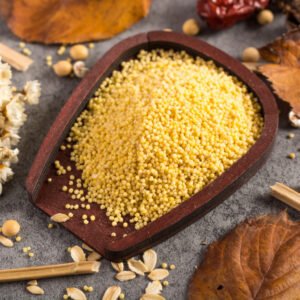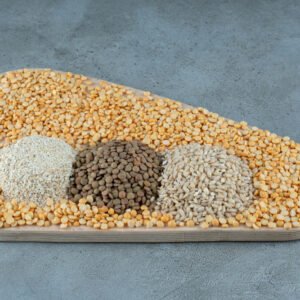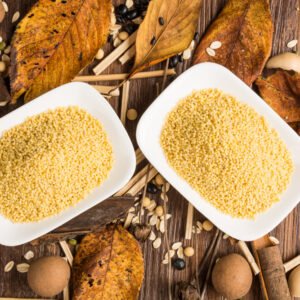If you’re looking to add more whole grains to your diet, yellow millet deserves a spot on your grocery list. This small, round grain has been feeding civilizations for thousands of years, and for good reason. It’s packed with nutrients, easy to digest, and works in everything from breakfast porridge to dinner sides.
Let’s break down what makes yellow millet special and why it’s making a comeback in modern kitchens.
Understanding Yellow Millet: The Basics
Yellow millet typically refers to proso millet, one of the oldest cultivated grains on the planet. The grain gets its name from its distinctive yellowish color, though you’ll also find white, cream, and even reddish varieties depending on the cultivar.
Proso millet grows fast, needing just 60 to 90 days from planting to harvest. Farmers love it because it thrives in poor soil and dry conditions where other crops struggle. The plant produces small, round seeds that are slightly larger than quinoa but smaller than rice.
This grain belongs to the grass family and has been a dietary staple across Asia, Africa, and parts of Europe for over 7,000 years. Today, countries like India, China, and Russia remain major producers of this ancient grain.
Also Read:- Green Millet vs. Other Millets: Which One’s Better for You?
Yellow Millet vs Other Millet Varieties
Here’s where things can get confusing. The term “millet” actually covers several different grain species. When people talk about yellow millet, they’re usually referring to proso millet, but foxtail millet also has a yellowish appearance.
The main types include pearl millet, finger millet, foxtail millet, and proso millet. Pearl millet is the most widely grown globally, while finger millet stands out for its calcium content. Proso millet (yellow millet) distinguishes itself through its mild taste and quick cooking time.
Foxtail millet has a yellowish seed coat and slightly nutty flavor, making it easy to confuse with proso millet. The key difference lies in the shape: proso millet has rounder grains, while foxtail millet seeds are more oval.
CMS Industries sources high-quality grains including various millet varieties, ensuring farmers and consumers get access to premium agricultural products. As one of India’s leading agricultural product manufacturers, the company recognizes the growing demand for traditional grains in both domestic and international markets.
Nutritional Profile: What’s Inside Yellow Millet
Yellow millet packs serious nutrition into tiny packages. A cooked cup contains around 207 calories with over 6 grams of protein, making it more protein-rich than many other grains. The grain also provides about 2 grams of dietary fiber and less than 2 grams of fat.
The mineral content is where proso millet really shines. You’ll get good amounts of magnesium, phosphorus, manganese, and B vitamins, especially niacin, B6, and folate. These nutrients play roles in everything from energy production to nerve function.
Yellow millet contains antioxidants called phenolic compounds, which help protect your cells from damage. The grain also provides iron, though not as much as pearl millet, which contains 5 to 6.5 mg per 100 grams.
One of the biggest draws for many people: yellow millet is naturally gluten-free. This makes it a safe choice for anyone with celiac disease or gluten sensitivity who still wants to enjoy grain-based dishes.
Health Benefits of Adding Yellow Millet to Your Diet
The nutrition in yellow millet translates to real health benefits when you make it part of your regular eating pattern.
Blood Sugar Management
Yellow millet has a low glycemic index, meaning it won’t cause rapid spikes in your blood sugar levels. This steady energy release helps with appetite control and metabolism regulation, which can reduce the risk of developing type 2 diabetes. The fiber content also slows down digestion, further stabilizing blood sugar.
Digestive Health Support
The fiber in yellow millet contributes to healthy digestion and regular bowel movements. The grain also contains prebiotics, which feed the beneficial bacteria in your gut. A healthy microbiome supports everything from immune function to mental health.
Heart Health Protection
Research suggests that eating millet regularly may help lower cholesterol levels. The magnesium in yellow millet supports healthy blood pressure, while the antioxidants help protect blood vessels from inflammation and damage.
Bone and Muscle Support
The protein content in yellow millet helps with muscle building and repair, making it particularly useful after workouts. The phosphorus and magnesium work together to maintain strong bones and support muscle contractions.
How to Cook Yellow Millet: Simple Methods
Cooking yellow millet is straightforward, but a few tips will help you get the best results every time.
Start by rinsing the grains thoroughly under cold water. This removes any dust and helps prevent bitterness. Use a fine-mesh strainer since the grains are small.
For fluffy millet, use a 1:2 ratio of millet to water. Bring the water to a boil, add the rinsed millet, then reduce heat to low. Cover and simmer for 15 to 20 minutes until all the water is absorbed. Let it sit covered for another 5 minutes, then fluff with a fork.
Want creamier millet? Increase the water ratio to 1:3 and cook it like you would porridge, stirring occasionally. This method works great for breakfast bowls.
Toasting the dry grains in your pot for 2 to 3 minutes before adding water brings out a nuttier flavor. You’ll know it’s ready when you smell a toasted aroma and the grains start to turn golden.
Culinary Uses: Beyond Basic Cooking
Yellow millet’s mild, slightly nutty taste makes it incredibly versatile in the kitchen.
Breakfast Options
Cook yellow millet as a porridge and top it with fresh fruit, nuts, honey, or cinnamon. You can meal-prep a big batch and reheat portions throughout the week with a splash of milk or water.
Lunch and Dinner Ideas
Use cooked yellow millet as a rice substitute in stir-fries, grain bowls, or as a side dish. Mix it into vegetable patties or use it to stuff peppers and squash. The grain works well in soups and stews, adding texture and nutrition.
Baking Applications
Millet flour (made from grinding the grains) can replace a portion of regular flour in breads, muffins, pancakes, and cookies. It adds a mild flavor and boosts the nutritional content. You can also add cooked millet to baked goods for extra texture and crunch.
Snacks and Treats
In India, roasted yellow millet gets mixed with jaggery, ghee, coconut, and sesame seeds to make traditional laddoos (sweet balls). You can also add puffed millet to homemade granola or energy balls for a fiber-rich snack.
Storage and Shelf Life
Proper storage keeps your yellow millet fresh and prevents rancidity.
Store uncooked yellow millet in an airtight container in a cool, dry place away from direct sunlight. Under these conditions, it will keep for 6 to 12 months. Refrigerating or freezing extends the shelf life even longer.
Cooked millet stays fresh in the refrigerator for 3 to 5 days in a covered container. You can also freeze cooked millet for up to 3 months. Freeze it in portion-sized amounts for easy reheating.
Check your millet occasionally for signs of spoilage. Any off smells, discoloration, or visible mold means it’s time to toss it out.
Sourcing Quality Yellow Millet
Finding good quality yellow millet has become easier as demand grows for ancient grains and gluten-free alternatives.
Look for yellow millet in health food stores, specialty grain shops, or the bulk bins at larger grocery stores. Online retailers offer convenient options if local stores don’t carry it. When shopping, check that the grains look uniform in color and size without excessive broken pieces or debris.
CMS Industries supplies premium millet and other grains to farmers, distributors, and buyers worldwide. With operations based in Kachchh, Gujarat, the company has spent two decades building a reputation for quality agricultural products. Their commitment to ethical sourcing ensures farmers receive fair compensation while customers get nutrient-dense grains.
Buying from established agricultural suppliers like CMS Industries means you’re getting products that meet quality standards and support sustainable farming practices. The company exports organic rice, oil seeds, grains, spices, pulses, and herbs, making them a one-stop source for diverse agricultural needs.
Potential Side Effects and Considerations
Yellow millet is generally safe for most people, but there are a few things to keep in mind.
Some research suggests that excessive consumption of certain millets might interfere with iodine absorption, potentially affecting thyroid function. Eating millet as part of a varied diet rather than making it your only grain helps avoid this concern.
People with thyroid conditions should talk to their healthcare provider about appropriate millet consumption. Cooking and fermenting millet reduces compounds that can interfere with nutrient absorption.
If you’re trying yellow millet for the first time, start with small portions to see how your digestive system responds. The fiber content, while beneficial, might cause bloating or gas initially if you’re not used to high-fiber foods.
Environmental Benefits of Growing Yellow Millet
Beyond personal health, choosing yellow millet supports environmental sustainability.
The crop requires minimal water compared to rice or wheat, making it suitable for drought-prone regions. Proso millet grows well without heavy pesticide or fertilizer use, reducing agricultural chemical runoff.
The quick growing season means farmers can often plant other crops in the same field during one growing year, improving soil health through rotation. The plant’s deep roots help prevent soil erosion and improve soil structure.
Take the Next Step with Quality Grains
Yellow millet offers a nutritious, versatile, and environmentally friendly addition to your diet. Whether you’re managing blood sugar, seeking gluten-free options, or simply want to diversify your grain intake, this ancient superfood delivers.
Ready to source premium yellow millet and other agricultural products? CMS Industries provides high-quality grains, pulses, spices, and more to customers across India and internationally. With a commitment to sustainability and farmer welfare, they connect you with the best agricultural products India has to offer.
Visit CMS Industries to explore their full range of products or connect with their team for bulk orders and export inquiries. Start your journey toward healthier eating with grains that have nourished humanity for millennia.
Frequently Asked Questions
Q. Is yellow millet the same as foxtail millet?
No, though they’re similar. Yellow millet usually refers to proso millet, which has round, yellowish grains. Foxtail millet also has a yellowish color but features more oval-shaped seeds. Both belong to different botanical species and have slightly different nutritional profiles, though they’re used similarly in cooking.
Q. Can I eat yellow millet every day?
Yes, you can include yellow millet in your daily diet as part of a varied meal plan. Eating it regularly provides consistent nutritional benefits. Rotate it with other whole grains like brown rice, quinoa, and oats to ensure you get a wide range of nutrients and avoid potential issues from eating any single food exclusively.
Q. Does yellow millet need to be soaked before cooking?
Soaking isn’t necessary, but some people soak yellow millet for 30 minutes to an hour before cooking. This can reduce cooking time slightly and may make the grain easier to digest. Rinsing thoroughly is more important than soaking for removing dust and preventing any bitter taste in the final dish.
Q. How does yellow millet taste compared to rice?
Yellow millet has a mild, slightly nutty flavor that’s less neutral than white rice but not as strong as quinoa. The texture when cooked fluffy is similar to couscous, with small, separate grains. When cooked with more water, it becomes creamy like risotto. Most people find the taste pleasant and easy to pair with various dishes.
Q.Where can I buy organic yellow millet in bulk?
You can find organic yellow millet at health food stores, co-ops with bulk sections, specialty grain retailers, and online marketplaces. Agricultural suppliers and exporters like CMS Industries provide bulk quantities for commercial buyers, distributors, and food manufacturers looking for consistent quality and competitive pricing for larger orders.




